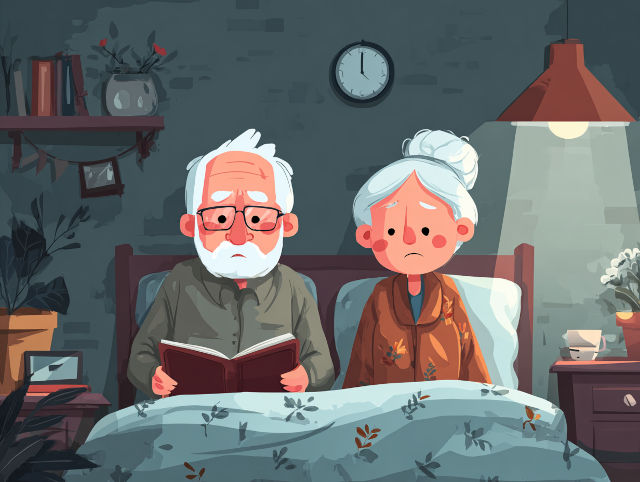Millions of older adults in the United States struggle with chronic insomnia, and many rely on prescription sleep medications to cope. These drugs, including benzodiazepines and Z-drugs such as Ambien, are often taken nightly and sometimes for far longer than medical guidelines recommend. While they can bring short-term relief by helping people fall asleep more easily, they also carry well-documented risks for older adults. These risks include increased likelihood of falls, fractures, memory problems, and physical dependence on the medication. Despite warnings from leading medical societies, the use of these drugs in older age has remained widespread, in part because sleep problems are so persistent and distressing. Older adults may feel they have no other workable option, and doctors sometimes continue prescriptions to avoid causing withdrawal symptoms or renewed insomnia, which can make it seem as though the medication is still necessary.
A recent study conducted by the USC Schaeffer Center for Health Policy & Economics suggests that reducing the use of sleep medications among older adults could lead to significant improvements in both health and life expectancy. The researchers used a detailed simulation model to examine what would happen if people aged fifty and older stopped taking these drugs. Their findings indicated that avoiding these medications could reduce the number of falls in later life by around 8.5 per cent and lower the risk of cognitive impairment by just over 2 per cent. These changes might sound modest on an individual level, but when applied to millions of people across the country, their impact becomes substantial. The researchers also estimated that older adults could gain an average of 1.3 months of additional life, totalling more than a million extra years of life across the population. Most importantly, this added time would be spent in relatively good health rather than simply extending years of frailty.
Sleep medication use is widespread among adults over fifty, with more than fifteen million people in this age group taking prescribed sleep aids. The prevalence tends to increase with age and is exceptionally high among women and white adults. While insomnia itself can be harmful and has been linked to depression, heart disease, and cognitive decline, the long-term use of medication is not proving to be the best answer for many individuals. Part of the difficulty is that withdrawal from these medications can be uncomfortable, causing anxiety and a return of sleeplessness that feels worse than before. This can create confusion for both patients and physicians, who may interpret the withdrawal symptoms as evidence that the medication is still needed. As a result, the prescription continues, even though it may no longer be providing true benefit, and may instead be contributing to further health challenges.
The economic consequences of reducing medication use are also notable. According to the study, avoiding sleep drugs in older adults would lead to an average lifetime savings of around $6,600 per person and approximately $101 billion nationally. These savings stem largely from improvements in health and quality of life, including avoiding falls that lead to hospitalisation and reducing the need for nursing home care. Older adults who fall and break a bone often face long recovery periods, reduced mobility, and, in some cases, a permanent loss of independence. By lowering the odds of these events, reducing the use of sleep medication could help more older adults maintain their daily routines, physical stability, and sense of autonomy for longer. In practical terms, this means fewer medical emergencies, fewer families facing sudden care needs, and a healthcare system less burdened by preventable injuries and complications.
One of the most promising alternatives to prescription sleep medication is cognitive behavioural therapy for insomnia, commonly known as CBT-I. This approach does not involve drugs but instead focuses on teaching individuals how to change habits and thought patterns that interfere with sleep. CBT-I helps people create more consistent sleep routines, address worries that can keep the mind active at night, and build healthier associations with the sleep environment. Research shows that CBT-I is just as effective as medication in the short term and more effective over time, with none of the harmful side effects. It can be delivered in person, through online sessions, or via structured mobile apps, making it accessible to many people. However, awareness and availability can vary, and many patients are not offered CBT-I as a first-line treatment. Encouraging physicians to recommend it more often could be a key step in reducing medication dependence.
The study also highlights several strategies that could help shift prescribing habits. For example, electronic health record systems could be set up to remind doctors of the potential risks when prescribing sleep medication to older adults, or to prompt them to consider alternative treatments. Clinicians might also receive routine feedback comparing their prescribing rates with those of their peers, encouraging reflection and adjustment. These types of interventions have been used successfully in the past to reduce unnecessary prescriptions for antibiotics and opioids. The goal is not to deny medication to those who genuinely need it, but to ensure that prescriptions are thoughtful, limited in duration, and accompanied by support for safer long-term strategies. The researchers emphasise that insomnia is a real and troubling problem for many older adults, and the aim is not to minimise the distress it causes, but instead to encourage solutions that lead to lasting improvements in well-being rather than continued risk.
In essence, reducing the use of prescription sleep medications among older adults represents a shift toward healthier aging. It encourages approaches that prioritise safety, independence, and cognitive clarity. It also acknowledges that sleep is not merely a medical issue but one deeply connected to emotional, social, and lifestyle factors. Helping older adults achieve better sleep without relying on drugs requires patience, guidance, and compassionate support. Yet the potential rewards are considerable: improved daily functioning, reduced risk of injury, enhanced mental sharpness, and a stronger sense of control over one’s health. By encouraging safer sleep practices and broadening access to effective non-drug treatments like CBT-I, both healthcare providers and patients can work together to create more sustainable and empowering approaches to sleep in later life.
More information: Hanke Heun-Johnson et al, Lifetime burden of prescription medication for insomnia in middle-aged and older adults in the US: a microsimulation study, The Lancet Regional Health – Americas. DOI: 10.1016/j.lana.2025.101284
Journal information: The Lancet Regional Health – Americas Provided by University of Southern California








